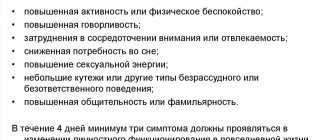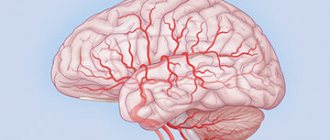General information about Korsakoff psychosis
Psychosis should not be confused with Korsakoff's syndrome. In the first case, the disease implies an alcoholic etiology (origin), while the development of the syndrome can be caused by other reasons not related to abuse , for example: traumatic brain injury, infection, hypoxia, tumors, various dementias.
Alcoholic Korsakov psychosis, as a mental disorder caused by prolonged exposure to alcohol on the human brain with mnestic disorders, as well as positive and negative symptoms, was first described by the Russian psychiatrist S. S. Korsakov in 1887. The disease occurs in a chronic form, observed in approximately 5% of those suffering from alcoholism. As a rule, it affects elderly people, less often middle-aged people. In most cases, the disease is accompanied by other pathologies caused by prolonged alcohol consumption (liver cirrhosis, cardiovascular diseases, dysfunction of the digestive system).
Risk factors and prognosis
There are risk factors for developing Korsakoff psychosis:
- experience of alcohol abuse for more than 10 years;
- alcoholic encephalopathy;
- mental disorders;
- exhausting diet;
- AIDS;
- pulmonary tuberculosis;
- abscess formation of the abdominal organs.
There is a direct relationship between the duration of the disease and the severity of the course, therefore, with timely initiation of therapy, complete recovery is possible.
If treatment is ineffective or the patient is unable to give up alcoholic beverages, the prognosis is unfavorable.
Causes of development of Korsakoff psychosis
The development of the disease occurs over a long period of time - 10–20 years. Symptoms of the chronic disorder often appear after an exacerbation of the psychosis that results from alcoholic encephalopathy. Also, the manifestation of characteristic symptoms can provoke complex delirium. Much less often, pathology develops in conditions of relative well-being in mental terms, without preliminary phenomena of a psychotic nature. Many sources cite the presence of somatic pathologies (especially the digestive system and liver) or traumatic injuries as provoking factors.
Diagnostics
Careful tests are required for an accurate diagnosis. The main indicator of the disease is vitamin B1 deficiency. To determine a vitamin deficiency, you need to take a blood test. After this, the vitamin is administered intravenously during the course of injections.
In addition, you need to test your memory. For this purpose, studies of the limbic system are prescribed. The limbic system is the oldest region of the human brain. It includes: hippocampus, cingulate gyrus, amygdala nuclei, piriform gyrus. The hippocampus is responsible for memory and learning. The system transfers short-term memory to long-term memory.
To test the functions of the system, various tests are used to help determine a person’s ability to remember information. The diagnosis is made when damage to at least one structure of the system is detected.
Obvious signs of the disease are impaired pupil movement and poor coordination.
Pathogenesis
There is an opinion that Korsakov's psychosis in alcoholism develops due to acute acquired deficiency of nicotinic acid and thiamine. A deficiency of biologically active substances occurs due to poor nutrition and disruption of the digestive system. Ethyl alcohol has a stimulating effect on the functioning of the small intestine, which plays a leading role in the process of digesting food and absorbing substances necessary for the normal functioning of the body. Due to the high speed of chyme movement, the small intestine is not able to properly absorb the required amount of vitamins. Atrophy of the intestinal mucosa, a characteristic result of prolonged exposure to alcohol, also a negative The lack of biologically active components leads to gradual degradation of limbic structures. Histological studies reveal massive death of the nerve tissue of the brain, which is also accompanied by the destruction of the nervous tissue of the spinal cord.
Korsakov's syndrome: causes of the disorder
The leading reason leading to the onset of Korsakoff's syndrome is a pronounced deficiency in the body of thiamine - vitamin B1. The main culprit of this deficiency is chronic alcoholism.
Long-term alcoholism and regular intoxication of the body with ethanol breakdown products lead to impaired absorption of thiamine. Since thiamine is a water-soluble compound, it is not stored in the body. The presence of ethanol in the blood inhibits the mechanisms of thiamine phosphorylation, which is necessary for the production of active coenzyme forms of vitamin B1. This, in turn, causes a significant decrease in the concentration of the active form of thiamine. Since thiamine is essential in the metabolism of carbohydrates, fats and proteins, its deficiency causes fatal neurological disorders.
A person who abuses alcohol develops acute or subacute damage to the midbrain and hypothalamus, called Gaye-Wernicke syndrome. In the absence of timely and adequate treatment, Wernicke encephalopathy becomes chronic, transforming into Korsakoff syndrome. At the same time, developing memory impairments and other defects are always severe, so the sick subject may require lifelong care.
The prevalence of Korsakov's syndrome has not been sufficiently studied, however, in recent years there has been a trend towards a decrease in the number of patients whose disorder is associated with alcoholism. This can be explained by the fact that when performing detoxification measures for acute alcohol disorders, thiamine is always present in the treatment regimen.
Korsakoff's syndrome is also present in a wide range of neurological pathologies, visceral diseases and other painful conditions. Cause of amnestic syndrome:
- benign and malignant neoplasms in brain structures;
- damage to brain tissue as a result of acute circulatory disorders and the resulting cerebral infarction;
- subarachnoid hemorrhage;
- contact damage to the soft tissues of the head, cranial structures, brain matter as a result of injuries;
- herpetic encephalitis is an acute infectious disease provoked by activation of the herpes simplex virus, which manifests itself in general cerebral and focal symptoms of central nervous system damage;
- limbic encephalitis is a neurological pathology in which the autoimmune inflammatory process is concentrated in the limbic structures.
Amnestic syndrome can develop due to chronic lack of nutrition due to prolonged fasting or prolonged adherence to strict diets. The onset of pathology can be provoked by biliopancreatic shunting - a malabsorptive operation, as a result of which the absorption of nutrients in the gastrointestinal tract is reduced.
Symptoms of Korsakov's psychosis
The first symptoms of Korsakoff psychosis appear long before the development of signs of a full clinical picture of the disease. Within 1–2 years before the formation of pathology, patients complain of aches, sensory disturbances and nagging pain in the lower extremities. The gait becomes unsteady. Problems become especially obvious a day after drinking alcohol. mental begin to appear - decreased quality of sleep, decreased sphere of interests, anxiety without an objective reason, fears.
At the next stage, as a rule, during the next binge or after the onset of a somatic illness, delirium begins, which results in the formation of a classic clinical picture of Korsakov's psychosis. Deterioration of the psyche without hallucinations and clouding of consciousness is possible, but such a development of the disease is observed quite rarely. Classic signs of pathology:
- severe form of amnesia;
- false memories;
- loss of orientation;
- polyneuritis of the legs.
Patients are most often aware of the presence of mental defects, so they try to hide them. They avoid direct answers when it comes to their well-being and try to steer the conversation in a different direction. Gaps in memory are replaced by fantasies, assumptions , passed off as events that actually happened. Facts get mixed up and lose their objective connection to place and time.
Other signs of Korsakov's psychosis are observed, for example, the manifestation of affective disorders - lethargy, passivity, or, conversely, causeless fussiness. There may also be manifestations of carelessness, bravado, inappropriate complacency or unreasonable anxiety accompanied by confusion. Deviations in the functioning of the nervous system become noticeable.
The disease occurs in one of two forms - regressive or stationary. In the first case, the manifestation of amnesia decreases, the volume of memories increases, including about past events. The stationary form is characterized by persistence of memory dysfunction.
Features of the clinical picture of Korsakoff's syndrome
In the totality of manifestations of Korsakoff's syndrome, a combination of paramnesia and amnestic disorder is observed.
Memory disorders
The patient experiences amnesia:
- retrograde, when very recent events are washed out of the memory, but old memories remain firmly in it;
- fixation – loss of the ability to remember new information, store it and reproduce it. A person is not able to record current events and those that happened recently. The patient seems to have everything in order with consciousness and motivation, but he instantly forgets what happened to him a couple of minutes ago.
The patient categorically does not recognize his illness and does not realize that he has lost his memory. At the same time, he will not say what he did an hour ago, what dishes breakfast or lunch consisted of. He remembers the words of what he read, but soon forgets not only them, but also that he was holding the book.
Paramnesia
Paramnesia refers to a memory disorder. This manifests itself in the fact that the patient develops false memories. The present shifts with the past, real events and invented ones are mixed. It is characteristic that the patient sincerely believes in his significant, decisive role in the incidents that once took place. Experts consider paramnesia to be qualitative memory distortions.
Alcoholism gives rise to several types of them.
Confabulation
This type is interpreted as erroneous, false memories. The patient has gaps in his memory, which he fills with fictitious plots and stories absolutely sincerely. Facts remembered in fragments flashing through the brain are completely distorted in the patient’s stories. He either modifies them, transfers them to another time, or combines them with fictional events.
Most often, patients with Korsakov's syndrome experience confabulations that are substitutes, that is, those that are close to reality. For example, the event that took place - watching a “star”’s concert on TV, is replaced by a personal visit to her dressing room and a joint performance on stage.
When memories become too fantastic, this means that Korsakov's psychosis has begun to develop. The patient can talk about his teleportation to Venus and his meeting with local beauties.
Korsakov psychosis
Pseudo-reminiscences
With this type of paramnesia, the patient's memory shifts the times of events that occurred. They once really existed, and the patient “drags” them from the past to the present.
Pseudo-reminiscences are equal to “memory illusions,” as experts call them. The patient speaks about them repeatedly and consistently. It is useless to argue that what happened was different.
The patient supplements his story with what once took place, but is not related to the main action. Invented elements of an insignificant nature also appear. The subject of most pseudo-reminiscences is absolutely ordinary.
Cryptomnesia
Lost memories in cryptomnesia are replaced by information once read or seen on TV or in the movies. The patient is confused between dreams and reality, a movie plot and episodes from his life.
It may seem to him that he traveled around the world for 80 days with Passepartout. And he recently saw in a movie that his son became a school boxing champion, and that boxer guy is just a fictional character in the film. There is nothing funny or tragic about this. The patient is simply sick, he has Korsakov's syndrome.
Affective disorders
A patient with alcohol dependence exhibits emotional instability. His mood changes instantly. One minute the patient was friendly and complacent, but a second later he developed anxiety and restlessness, easily turning into aggression.
Affective disorders manifest themselves:
- fatigue and lifelessness;
- motor retardation;
- sadness and inability to concentrate on one thing.
Taken together, this is characterized as asthenic depression. All he can do is lie:
Diagnosis of Korsakov's alcoholic psychosis
For specialists, identifying Korsakov's alcoholic polyneuritic psychosis is not difficult. The presence of pathology is obvious. The diagnostic procedure includes:
- Examination by a psychiatrist. The nature of amnesia, its severity, the degree of loss of orientation, the presence of hallucinations, and delusions are clarified. A significant role is played by the patient’s relatives and friends, who are able to provide truthful information about the patient’s behavior in everyday life, the duration of alcohol consumption, the presence of preliminary symptoms and triggering factors of the disease.
- Examination by a neurologist. The presence and degree of development of polyneuritis is revealed. The doctor also pays attention to muscle atrophy, paresis of the limbs, function of the eye muscles, identifies the presence of an unsteady gait, and a violation of the coordinated functioning of the muscles.
- Examination by specialists of various profiles. There is often a need to seek advice from a cardiologist, gastroenterologist and other highly specialized doctors to clarify the presence and degree of development of somatic disorders.
- Laboratory research. It is necessary to undergo hardware examinations - EEG, MRI of the brain and abdominal cavity, computed tomography (CT) of internal organs. A detailed biochemical blood test is also required.
It is necessary to carry out differential diagnosis. Some symptoms of the disease are also characteristic of: Korsakoff's syndrome, atherosclerosis, progressive paralysis.
Buy online
Alcohol abuse is one of the leading causes of central nervous system damage. In 75% of cases, autopsy in cases of alcohol abuse reveals some degree of atrophic changes in the brain, and 50% of patients undergoing alcohol detoxification show memory impairment and other cognitive disorders [45].
Alcohol damage to the central nervous system manifests itself as both neurological and mental disorders, forming one of the border areas between neurology and psychiatry.
Of particular importance for clinical practice are two related, most dangerous and prognostically unfavorable forms of alcoholic brain damage - Wernicke encephalopathy and Korsakoff's psychosis, which form the subject of this review, which reflects the work of the last two decades.
Brief history of the issue and taxonomy
In 1881, the largest German neurologist, psychiatrist and neuromorphologist C. Wernicke described a suddenly developing disorder, manifested by severe neurological and mental disorders with a fatal outcome, and proposed calling the condition he described acute superior hemorrhagic polioencephalitis ( polyoencephalitis hemorrhagica superior acuta
). Later, the disease described by the author was named in his honor and in modern terminology is designated by the term “Wernicke encephalopathy.”
A few years later S.S. Korsakov [2] published his own observations of a special mental disorder, which formed the basis of his doctoral dissertation “On Alcoholic Paralysis.” It described memory impairments (mainly short-term) that develop in individuals suffering from severe alcoholism and multiple lesions of the nervous system (“multiple neuritis” in the terms of that time). These disorders S.S. Korsakov called it “polyneuritic psychosis” or “mental toxemic cerebropathy”. He associated their development with the action of a hypothetical toxic (“toxemic”) factor. Only years later it became known that Wernicke's superior hemorrhagic polioencephalitis and Korsakov's polyneuritic psychosis were based on the same cause - a lack of thiamine (vitamin B1). At the suggestion of the German neurologist and psychiatrist F. Jolly, the described S.S. Korsakov called polyneuritic psychosis from 1897 to the present day Korsakov psychosis.
K. Bonhoeffer, who disputed the nosological independence of polyneuritic psychosis (which, it must be said, was not insisted on by S.S. Korsakov himself, who emphasized the possibility of a non-alcoholic origin of the damage to the nervous system he described), proposed calling specific memory disorders in various diseases Korsakov syndrome or amnestic symptom complex .
In the domestic literature, a distinction is still made between Korsakov's psychosis (developing with alcoholism) and Korsakov's syndrome (of non-alcoholic origin), while outside our country these concepts are usually synonymous, with the second being used much more often than the first.
Along with Wernicke encephalopathy and Korsakoff psychosis, the concept of Wernicke-Korsakoff syndrome as a single disease with a common etiology is often used in modern (mostly foreign) literature.
In accordance with the unitary concept, Wernicke-Korsakoff syndrome manifests itself in two stages: acute, often reversible, especially with timely initiation of therapy - Wernicke encephalopathy, and chronic, usually irreversible or poorly reversible, developing with an unfavorable course of Wernicke encephalopathy, as well as in the absence of adequate treatment - Korsakoff psychosis [21, 36].
Epidemiology
Wernicke encephalopathy and Korsakoff's disease develop in less than 1% of alcohol abusers, which apparently reflects the low incidence of critically reduced transketolase activity in the corresponding areas of the brain [34, 39].
It is believed that for the development of Wernicke-Korsakoff syndrome a special hereditary predisposition is necessary, most likely a genetically determined increased sensitivity of the nervous tissue to thiamine deficiency and the increased vulnerability of certain areas of the brain arising in connection with it (as well as with other possible pathogenetic factors), including associated with memory consolidation, to the action of glutamate [19]. The rarity of the presence of this predisposition, apparently, should explain the low frequency of Wernicke-Korsakoff syndrome.
It should be noted that Korsakov's psychosis develops much less frequently than Wernicke's encephalopathy; According to some data, the frequency of transformation of one disease into another does not exceed 28% [23].
Etiology and pathogenesis
The main cause of Wernicke-Korsakoff syndrome is thiamine deficiency associated with one or more of the following reasons: 1) insufficient intake of the vitamin from food; 2) violation of its intestinal absorption (malabsorption syndrome); 3) decreased ability of the liver to accumulate vitamin reserves; 4) inhibition of phosphorylation processes.
As a result of phosphorylation reactions, thiamine is converted into thiamine pyrophosphate (TPP), which plays the role of an active fragment (coenzyme) of the so-called TPP-dependent enzymes, which include pyruvate dehydrogenase, α-ketoglutarate dehydrogenase and transketolase.
Thiamine deficiency and/or inhibition of phosphorylation processes, often accompanying severe forms of alcohol abuse, lead to insufficient formation of TPP and a decrease in the activity of TPP-dependent enzymes (primarily transketolase), which catalyze many biochemical reactions, including those ensuring the metabolism of nervous tissue. TPP-dependent enzymes are involved in carbohydrate metabolism (glycolysis and pentose phosphate cycle), ethanol metabolism and gamma-aminobutyric acid (GABA) synthesis. A decrease in the intensity of the three listed types of biochemical reactions is of direct importance for alcoholic damage to the nervous system, including the development of foci of brain atrophy.
A decrease in the content of GABA (as well as aspartate) and local lactic acidosis, associated with thiamine deficiency and a decrease in the activity of TPP-dependent enzymes, cause biochemical changes in the nervous tissue. The altered biochemical background causes increased vulnerability of the nervous tissue to the damaging effects of glutamate.
The excitotoxic effects of glutamate are caused by the formation of hypersensitivity of NMDA receptors (of which it is a biogenic ligand) during systematic alcohol abuse and its massive release from connection with these receptors during the period of acute alcohol withdrawal with rapidly developing damaging effects on nervous tissue [5, 49].
It can be assumed that the reversibility of acute alcohol disorders depends on the degree of the damaging effect of glutamate. If this effect is small, changes in the central nervous system are in the nature of “biochemical damage” and have a certain ability to reverse development. The stronger excitotoxic effect of glutamate leads to apoptosis and death of nerve cells and the development of irreversible or poorly reversible neurodegenerative changes. In the light of these ideas, it becomes obvious that alcohol withdrawal syndrome is that phase state in patients with alcoholism, during which atrophic processes in the central nervous system primarily develop. Therefore, to prevent the cascade development of neurometabolic changes, therapeutic measures when patients with alcoholism are admitted to the clinic must begin as early as possible, when the first signs of alcohol withdrawal syndrome appear or even with their anticipation.
Severe thiamine deficiency with the development of acute Wernicke encephalopathy in alcohol abusers can be triggered by a carbohydrate load (for example, with intravenous glucose preparations during alcohol detoxification), prolonged vomiting or gastrointestinal disease.
The more severe the thiamine deficiency, the greater the likelihood of Wernicke encephalopathy developing into Korsakoff's psychosis [48].
Along with thiamine deficiency, oxidative stress and increased DNA damage play a role in the development of encephalopathy. Disturbances in blood osmolarity that accompany alcohol abuse contribute (in interaction with other factors, such as lactic acidosis) to the occurrence of acute demyelination processes [51].
Inflammatory processes in brain tissue caused by activation of microglial cells are considered as an intermediate pathogenetic link between thiamine deficiency and impairment of neurological and mental functions [47].
There are few observations of the development of Wernicke encephalopathy in connection with anorexia nervosa combined with alcohol abuse. Neurological and mental disorders in such cases may be more severe than with isolated alcohol abuse.
L. Saad et al. [33] described Wernicke's encephalopathy in a 45-year-old woman who suffered from anorexia nervosa and alcoholism, whose thiamine deficiency was combined with severe magnesium deficiency, and typical manifestations of acutely developed encephalopathy were accompanied by megaloblastic anemia. Despite the intravenous administration of high doses of thiamine (in combination with magnesium), which usually contributes to a rapid and complete reduction of the symptoms of the disease, during the treatment the patient lost all manifestations of acute encephalopathy, except for severe memory impairment, which became irreversible. Based on the described observation and literature data, the authors of the report concluded that anorexia nervosa worsens the course of Wernicke encephalopathy and contributes to its transformation into Korsakoff syndrome.
Wernicke-Korsakoff syndrome (as well as its isolated stages) can be of non-alcoholic origin and develop in other diseases accompanied by thiamine deficiency, including diseases of the stomach and intestines, repeated vomiting, malnutrition, diseases of the thyroid gland, and also in connection with surgical interventions on the stomach and intestines [4, 7, 20, 24, 30, 37].
The risk of developing Wernicke encephalopathy in the practice of abdominal surgery increases with the number and volume of operations and their complications, as well as in the presence of intestinal bleeding, and the problem is aggravated by the high proportion of unrecognized cases [31].
There have been cases of the development of Wernicke encephalopathy in childhood and adolescence [11, 43]. Early onset of the disease is associated with factors such as malnutrition, prolonged parenteral nutrition, malignancy and HIV infection [11].
Clinical manifestations and dynamics
Wernicke's encephalopathy.
In accordance with classical descriptions, Wernicke encephalopathy is characterized by a tetrad of symptoms[]: gaze paralysis (ophthalmoplegia), associated with damage to the fourth pair of cranial nerves; nystagmus; cerebellar ataxia; confusion (amentia).
There is a point of view (shared by the authors of this article) that the tetrad of neuropsychiatric manifestations of Wernicke encephalopathy can be expanded (at least in some cases) to a pentad due to memory impairment [13]. As a rule, memory impairments in the structure of Wernicke encephalopathy have mild manifestations, becoming more pronounced and often irreversible when they result in Korsakoff syndrome.
In addition to the listed symptoms, patients may experience nausea, vomiting, increased or decreased body temperature, arterial hypotension, and in rare cases, coma.
It should be noted that in most patients the complete classic tetrad of symptoms of Wernicke encephalopathy mentioned above is absent. The disease often (according to some authors - in more than 80% of cases [7, 12]) occurs with a minimal set of clinical signs and remains unrecognized, and, therefore, patients do not receive the necessary treatment.
If recovery does not occur within 48-72 hours, in most cases (as in the absence of treatment), Wernicke encephalopathy turns into Korsakoff psychosis.
The mortality rate for Wernicke encephalopathy in the absence of treatment lies in the range of 10-20%.
It is believed [35, 42] that insufficient recognition of Wernicke encephalopathy and, consequently, the lack of treatment can worsen the processes of normal aging of the brain and increase the risk of developing neurodegenerative diseases, including Alzheimer's disease.
Wernicke encephalopathy can be combined with other forms of alcoholic brain damage - for example, delirium delirium, central pontine myelinolysis, alcoholic pellagra [9, 21, 36, 38].
Korsakov psychosis.
The main manifestation of Korsakov's psychosis is memory disorders, which give rise to another name for this condition - an amnestic symptom complex, which includes all types of memory impairments, with a clear predominance of fixation amnesia - a sharp weakening of memory for current events with relative preservation of memory about past events.
Fixation amnesia in Korsakov's psychosis is clearly illustrated by a classic description belonging to S.S. himself. Korsakov [3]: “From one patient I had to hear almost constantly the following: “I’ve been lying down today, now I’ll get up - only this very minute my legs somehow cramped - as soon as they separate, I’ll get up.” He had a long-term contracture in his knees, but, not remembering its existence, he believed that this was only a matter of the moment. This same patient categorically claimed that he had no pain in his legs, but meanwhile he had very strong shooting pains: when he shot, he would scream, and then immediately answer the question that he had absolutely no pain. ... The same patient, reading a newspaper, could read the same line ten times in a row as something completely new; it happened that by chance his eyes would stop on something interesting, and he would read this line out loud to his mother and laugh; but at this time, of course, he will take his eyes off the place he was reading for a few seconds, and then, when his eyes again fall on this place, at least right away, he again with the same words: “listen, mom” - reads this passage, and thus can be repeated many times..."
In severe cases, manifestations of fixation amnesia can reach the level of amnestic disorientation.
The fundamental difference between Korsakov's psychosis and dementia is the selective nature of mental disorders, which practically do not go beyond the limits of cognitive impairment, while maintaining the personality.
Symptoms of amnesia in patients with Korsakoff psychosis are sometimes accompanied by confabulations that fill amnestic “gaps.”
Additional symptoms of Korsakoff's psychosis include apathy and other mood disorders [1].
Both Wernicke's encephalopathy and Korsakoff's psychosis are often accompanied by damage to the peripheral nerves, which today, as a rule, does not reach such severity as in the times of K. Wernicke and S.S. Korsakov.
Pathological anatomy
A common morphological feature of Wernicke encephalopathy and Korsakoff's psychosis is damage to the mamillary bodies, periaqueductal (sometimes cortical) gray matter, basal ganglia, thalamus optica (especially its medial nuclei), pons and medulla oblongata.
Violation of the integrity of the circuit including the thalamus, mammillary bodies, frontal lobes and cerebellum - a complex of formations that are crucial for the formation of memory and executive functions - is associated with the development of an amnestic symptom complex as the main manifestation of Korsakoff's psychosis [18, 51].
According to other authors [19, 22], changes in the prefrontal cortex and especially its ventromedial and orbitofrontal areas, as well as the mamillary bodies, anterior parts of the thalamus opticum and the mamillothalamic tract are of particular importance for the occurrence of specific unconsciousness characteristic of Korsakoff psychosis.
Microscopic examination of the paraventricular and periaqueductal gray matter reveals neuronal loss, gliosis, and small hemorrhages [19].
Diagnostics
As mentioned above, due to the paucity of clinical manifestations, Wernicke encephalopathy often remains unrecognized, and therefore, in many cases, the disease is detected only during autopsy or during neuroimaging studies as an incidental diagnostic finding [27, 41, 42, 50, 51].
The unsatisfactory detection of Wernicke encephalopathy is to a certain extent explained by the fact that many doctors traditionally believe that this disease develops exclusively in patients with alcoholism, without taking into account the possibility of its non-alcoholic origin [12].
Difficult recognition of Wernicke encephalopathy is associated with a certain “fragility” of diagnostic criteria: encephalopathy can develop with normal or even increased levels of thiamine in the blood [10, 23], and in some cases there is an obvious (clinical or experimental) picture of the disease with clear dysfunction of the hippocampus and other structures There are no specific neuromorphological changes in the central nervous system (including those documented by neuroimaging methods) [23, 46]. Thus, we have to admit that, despite the modern capabilities of clinical and laboratory diagnostics, reliable tools for the timely detection of Wernicke encephalopathy still do not exist, and the disease has the character of a “diagnostic puzzle” [16, 23].
Unlike Wernicke's encephalopathy, Korsakoff's psychosis, due to its obvious clinical manifestations and high frequency of irreversible course with loss of ability to work, is much less likely to remain unrecognized.
Prevention and treatment
Effective measures to prevent Wernicke-Korsakoff syndrome include treatment of diseases leading to its development, including alcohol addiction and diseases of the gastrointestinal tract.
The need to prevent the development of Wernicke encephalopathy justifies the prescription of courses of preventive intramuscular administration of thiamine to patients who abuse alcohol and suffer from alcohol dependence [14].
An important preventive measure is also the preventive administration of thiamine in gastroenterological and surgical practice for diseases accompanied by the risk of developing thiamine deficiency.
The addition of thiamine to food products is considered as one of the measures to prevent hypovitaminosis and associated Wernicke-Korsakoff syndrome and diseases of the nervous system [14]. It has been shown that in countries where such measures are practiced, the incidence of Wernicke encephalopathy is reduced [21].
Parenteral administration of thiamine is the main and practically the only method of treating developed Wernicke encephalopathy.
The dramatic paradox of Wernicke encephalopathy is that, as mentioned above, it is often difficult to recognize, but with timely diagnosis it is quite easy to cure. Lack of treatment in many cases means an unfavorable (disabling or even fatal) outcome. Emergency initiation of etiotropic therapy usually allows for a significant reduction in the symptoms of the disease and reduces the risk of death and the transition of acute encephalopathy to the final state - Korsakov's psychosis [7, 48]. Thus, timely administration of thiamine is of vital importance for patients.
Due to the fact that Wernicke encephalopathy often occurs with scant manifestations and remains unrecognized, it is believed that treatment should begin when any of its symptoms are identified.
Many experts justify the need for high initial doses of the vitamin (with their subsequent reduction) and a long course of therapy.
T. Paparrigopoulos et al. [29] report a complete reduction of neurological and psychopathological symptoms of a severe form of Wernicke-Korsakoff syndrome after a 2-month course of a very high dose of thiamine - 900 mg per day, with 600 mg prescribed per os
and 300 mg was administered intravenously.
According to A. Thomson et al. [40], intravenous administration of 1000 mg of thiamine on the 1st day can lead to significant success in the treatment of Wernicke encephalopathy.
Subsequently, as the patients' condition improves, daily doses of thiamine are reduced to 100-300 mg.
The regression of symptoms of Wernicke encephalopathy during treatment is dissociated: first of all, there is a reduction in oculomotor disorders and other neurological disorders, while clouding of consciousness, as well as cognitive dysfunction, persist much longer [7].
The recommended duration of treatment with thiamine for Wernicke encephalopathy is at least 2-3 months, and for Korsakoff psychosis it reaches 2 years [21, 36].
Due to the fact that thiamine deficiency in alcohol abusers is usually accompanied by a deficiency of magnesium ions, which plays a certain role in the occurrence of brain and mental dysfunction, magnesium administration can accelerate the reduction of manifestations of acute encephalopathy [41].
Memantine (akatinol) is considered as one of the promising treatments for both acute alcohol disorders and alcohol dependence itself.
A. Rustembegović et al. [32] reported good tolerability and significant superiority of memantine (10 mg daily for 28 weeks) over placebo in improving cognitive and functional outcomes in patients suffering from Wernicke-Korsakoff syndrome.
Parenteral administration of memantine to newborn rats reduces motor impairment and reduces the number of cell deaths caused by alcohol [15].
An open-label 12-week study [8] showed a significant improvement in overall cognitive functioning, an increase in quality of life and a decrease in behavioral disturbances in patients suffering from alcoholic dementia under the influence of memantine at a daily dose of 20 mg.
Along with its ability to reduce the manifestations of alcohol-induced brain damage, memantine has demonstrated the ability to reduce the severity of alcohol dependence.
In a study by G. Malpass et al. [26] demonstrated the dose-dependent ability of memantine to reduce ethanol consumption in alcohol-preferring rats. In addition, memantine caused a partial reversal of the effects of alcohol such as sedation and inhibition of motor activity. The side effects of memantine in this study were significantly less pronounced than those of other NMDA receptor antagonists - phencyclidine, ketamine and the drug MK 801.
J. Jeanblanc et al. [17] note a decrease in self-administration of ethanol and motivation for its use in laboratory animals under the influence of memantine. The authors show that the noted effect of memantine is realized with the participation of brain-derived neurotrophic factor (BDNF).
BDNF has a protein structure and belongs to the family of neurotrophins, which are of great importance in the functioning of the nervous system, including in the processes of memory consolidation. The compound plays a significant role in the development of many mental illnesses, including schizophrenia, affective psychoses, dementia and substance abuse [44].
In a double-blind, randomized study of the comparative effectiveness of memantine and escitalopram, both drugs were found to have almost equal ability to alleviate the condition of patients suffering from major depressive disorder in combination with alcohol dependence (reducing alcohol consumption, improving emotional state and quality of life, reducing the level of depression and anxiety on the Montgomery scale -Asberg and Hamilton) [28].
As in the treatment of other forms of cerebral atrophy (for example, dementia of the Alzheimer's type), donepezil and other acetylcholinesterase inhibitors are used in the treatment of amnestic symptom complex in patients with alcoholism [6].
It has been shown that lithium, until recently considered exclusively as a mood stabilizer, due to its ability to prevent neuronal apoptosis, can act as a neuroprotector and prevent the development of cerebral atrophy both in neurodegenerative processes, such as Alzheimer's and Parkinson's diseases, and in Wernicke-Korsakoff syndrome [25].
Despite persistent cognitive deficits, which are based on irreversible morphological changes in the brain, many patients with Korsakoff's psychosis are capable of learning, especially in the presence of a comfortable environment and a constant supply of new information that is significant for them [19].
In modern understanding of Wernicke-Korsakoff syndrome, many unresolved questions remain. The development mechanisms and risk factors for Wernicke encephalopathy and Korsakoff psychosis require clarification. Diagnostic tools that allow timely recognition of Wernicke encephalopathy and, even more so, to predict its occurrence are far from perfect. All of the above determines the need for new experimental and clinical research in this area of psychiatry and neurology.
[]Many authors talk about a triad of symptoms of Wernicke's encephalopathy, combining nystagmus and ophthalmoplegia into one symptom.
Treatment of Korsakov's psychosis
If Korsakoff psychosis is clearly diagnosed, treatment will be comprehensive, aimed at localizing the damage and restoring various body functions. The acute course of the disease requires keeping the patient in a hospital setting. Treatment is carried out by psychiatrists, narcologists, neurologists and other specialized specialists. List of therapeutic measures:
- Eliminating the possibility of drinking alcohol. An obligatory and main component of treatment. Already at this stage, restoration of some functions is observed, and the risk of further deterioration of the condition is significantly reduced.
- Detoxification. It starts from the first days of therapy. Includes infusion of saline solutions, administration of glucose, and the use of other drugs.
- Vitamin therapy. It consists of saturating the body with B vitamins. This is an effective method of treating polyneuritis, eliminating or significantly reducing the manifestation of neurological disorders.
- General care and supervision. Necessary for serious problems with orientation, passivity, and severe forms of amnesia. The medical staff monitors the implementation of hygiene procedures, compliance with the regime, and physical activity. Bedridden patients require special care to resist the development of pressure ulcers and hypoventilation pneumonia.
- Physiotherapy. Massage, hardware, gymnastics to prevent complications of diseases of internal organs, alleviate polyneuritis, stop muscle atrophy.
After the exacerbation has resolved, further observation is possible in a hospital setting or at home, if relatives and friends guarantee compliance with doctors’ orders.
Forecast and prevention of Korsakoff psychosis
In general, if the prescribed treatment is followed, the prognosis is favorable. Korsakoff psychosis tends to have a regressive course, especially in middle-aged and young patients. If the severity of amnesia does not decrease, then successful learning to compensate for impaired memory function is possible. Partial restoration of working capacity is possible in most cases, complete restoration is extremely rare. Some intellectual and emotional problems persist. Adverse consequences are possible if medical care is not provided in a timely manner: dementia, transition of the disease to a malignant form with a fatal outcome within 1–2 years.
The only prevention is absolute lifelong abstinence from drinking alcohol.
Treatment
Korsakoff psychosis requires an integrated approach to therapy.
- Refusal of drinking alcoholic beverages.
- A balanced diet, the diet of which includes all the necessary vitamins and elements.
- Detoxification of the body using infusion therapy allows toxic substances to be removed from the body, thereby preventing further effects of metabolites on nerve cells.
- Nootropics can increase the activity of neurons - Piracetam.
- Introduction of B vitamins, which have a beneficial effect on the condition of nerve cells.
- Neuroleptics in the presence of delirious conditions.










